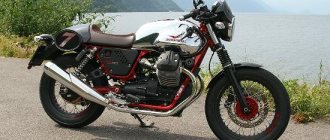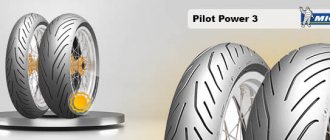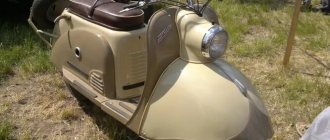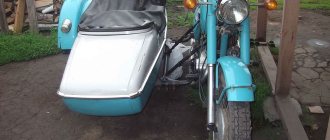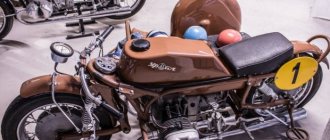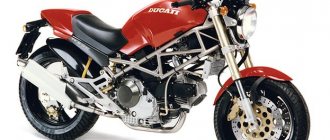Harley Davidson SA Peashooter 1928
It reflects the trends of those years - the fashion for single-cylinder engines. Despite the enormous competition, the American manufacturer has produced a whole range of similar equipment. First, Model A and B were born in 1926. The first was equipped with a magneto, the second with a coil and battery.
The volume of their V-shaped engine was 350 cubic meters, the valves were on the side. In the S model they were made on top. She could accelerate to 160 km/h. When driving, the exhaust pipe made specific sounds, which is reflected in the name. Translated from English it means toy gun.
Autoped
The American one can be considered the parent of modern scooters; it was the first to attempt to create a full-fledged scooter for moving around a big city.
The first prototype of this retro scooter was announced in 1914, and production started in 1916 after a number of improvements were made. The first scooter had a four-stroke engine in its design and had a power of 1.5 hp. The front wheel was driven through a multi-plate clutch.
Weighing only 50 kg, the price of the scooter was one hundred and ten dollars. The composition also included a lighting headlight and a signal. To make it easier to carry the scooter, it was possible to attach the folded handlebars to the rear fender.
After ending scooter production in 1920, Krupp began producing an improved scooter model in Germany in 1921.
Vincent Comet 1950
This sportbike was called a comet because of its rapid acceleration. Although its maximum is modest - 140 kilometers per hour (by modern standards). For racing of those years, this was solid. The design is equipped with many components that can be adjusted - steering wheel, footrests, etc.
Developer Philip K. Vincent paid special attention to the operation of the valves. He ensured that it was optimal at different engine speeds. The solution was found in moving the camshaft higher than usual.
A forked rocker arm was also installed. Thanks to this approach, the valves opened more accurately. The engineer's most interesting discovery is the triangulated rear suspension. This innovation seemed to come from the future. The disadvantages of the bike included high fuel consumption.
Keepers of Time - the living history of Soviet motorcycles
The history of our country, unlike many other states where the culture of preserving historical artifacts is at an unattainably high level, is literally falling apart through our fingers. Objects of cultural heritage are often destroyed or thrown away, and the creation of local history collections and the organization of thematic museums is still mainly the lot of individual enthusiasts. Today’s post is the final one within the week of good stories and is dedicated to people who cherish our past.
We’re not talking about, say, the guys from Retro Scooters: despite the fact that some members of this club are indeed connoisseurs of the classics, for the majority of retro scooterists, a vintage scooter is a way to stand out from the crowd and a certain lifestyle. Most of them were born in the 90s and almost everyone makes their choice in favor of “remakes” - modern models stylized as “retro”.
Young dudes are rarely true fans of retro, but only follow trends. Photo from the Retro Scooters group.
Not everyone is interested in the real “old school”, and only a few are capable of tinkering with their grandfather’s Ural. And equipment of this age will definitely require maintenance, which, in the absence of original parts and available specialized services, can only be fully carried out by the owner himself.
Originally, the term “moped” meant a motorcycle equipped with pedals. In the photo, Soviet Verkhovyna from the site Drive2.ru
Of course, there are professional workshops that restore and service classic motorcycle models, but the cost of their services is unattainably high for many motorcycle enthusiasts.
However, this does not mean that the technicians servicing customer equipment are not fans of retro bikes themselves. For example, brutal restorers from St. Petersburg, Timur Sanych and his team, have turned a long-time hobby into a business and, in addition to commercial projects, conduct educational work, publish video reviews on YouTube and even play Java, which is being restored online.
The legendary rare Jawa “old lady” in this condition will cost a lot of money. Photo from the Retrocycle group.
Interest in retro technology is growing every year, because this is an excellent opportunity to touch the history of the world motorcycle industry and be surprised at how much the design and appearance of motorcycles has changed in just a few decades. Many global motorcycle manufacturers have recently significantly increased their range of replicas of old models and bikes made in retro style.
This fuel-injected Triumph of the 2015 model year has an intake system styled like a carburetor, as a tribute to style. But the cost of such a technological beauty in the showroom of an official dealer is almost 700,000 rubles...
In Russia this direction is also developing. In Moscow, sales of classic and relatively inexpensive Royal Enfields have recently started, although they have not yet “taken off” (apparently Russian consumers prefer modern sports-looking cars to archaic-looking models), and in St. Petersburg, vintage Indianas are quite successfully sold for the price of a good apartment in the northern capital .
The 2015 model year Indian Scout is worth... But by the way, just admire this car.
Numerous exhibitions and events dedicated to retro technology and motorcycles in particular are also organized. In addition to the largest exhibitions such as the Ilya Sorokin Gallery or the Vadim Zadorozhny Museum of Technology, which also include vintage motorcycles, there are a number of lesser-known organizations that introduce us to the history of motorcycles.
For example, the international amateur championship Moscow Classic Grand Prix is held - spectacular racing on classic cars, and enthusiasts from Motoclassics organized the first gathering of vintage motorcycle enthusiasts this year.
And this is what the ancestors of modern Indians looked like... Exhibition at the Vadim Zadorozhny Museum of Technology. The author of the photo is Natalya “Poznamka”.
But besides public organizations, whose names you can find on banners and billboards, there are also “little people” who are trying their best to preserve a piece of the past for future generations. We would like to tell you more about them, so the release of the article was a little delayed - the editors of Omoimot talked with the heroes of our time personally to introduce readers to the real stories of their lives.
Moped Museum
Vladimir Gordeev is a fairly famous person in the motorcycle community. A regular at the Moscow Scooter Club, known on this forum as Bio-max, for many years helped scooterists and motorcyclists rescue faulty equipment in a small truck equipped as a motorcycle tow truck.
Bio-Vova's red van, as his teammates call it, was a constant companion at the outings of various motorcycle clubs and accompanied the bikers along the way. Photo from the Moscow Scooter Club forum.
As a true fan of retro technology, Vladimir has collected a significant collection of classic mopeds and mopeds, which were originally exhibited at the Museum of Industrial Culture in Moscow.
The first exhibits as part of a temporary exhibition at the Museum of Industrial Culture
Dreams of a real museum were in the air, and one day the Gordeev family radically changed their lives - having moved from their historical place, they moved from Moscow to Vitebsk (Republic of Belarus) to organize a real Moped Museum there.
The rhythm of life there and the opportunities for realizing their ideas seemed ideal to Vladimir and his wife: the opportunity arose to purchase an entire house in which it was planned to house the exhibition.
Drawing of Vladimir's wife, where it all began
Realities made their own adjustments and everything did not work out right away, but today the Moped Museum is a place very similar to the dreams of an enthusiast.
Omoimot's interview with the creator of the Moped Museum, Vladimir Gordeev:
Vladimir gave comments by email, since at that moment he was traveling to Moscow to buy new exhibits for the museum and the upcoming exhibition in Minsk.
Omoimot: Vladimir, tell us about yourself. How did you become interested in scooters?
Vladimir Gordeev: I’m 46 now, and I haven’t been in the “mototheme” for very long, about 14 years. I bought my first scooter almost by accident, after a trip to Moto-Maloyaroslavets. At the festival I rode a Yamaha Slider for the first time and bought it a week later. A little later I registered for MSC, started evacuating and away we go! 
Interest in mopeds appeared after the second compression fracture of the spine... While I was resting at home without work, I came across the Dyrchik website and became interested in the history of small-capacity motorcycles, old models of mopeds and scooters.
From this interest grew a small history website on which I collected useful information about the characteristics and repair of old mopeds. Almost simultaneously with the site, I accidentally bought my first moped to save it from scrap metal. Then the second, third. I began to consciously buy rare things in order to preserve them.
Not all exhibits arrive at the museum in good condition—some have to be restored literally piece by piece.
As the collection grew, the idea of a museum as a space rather than a virtual site took shape. Initially, mopeds were exhibited in Moscow, at the Museum of Industrial Culture in Lyublino.
What are you driving now?
As a matter of principle, I continue to ride scooters. Now – Piaggio Skipper 150 with big block from 1999.
What do you recommend for beginner scooter riders?
There are many recommendations, it’s impossible to list them all, but I can say for sure that I don’t travel without a full set of protection at all. I’ve seen a lot of different accidents, including stupid ones, and most importantly, as a tow truck driver, I’ve seen their consequences.
Riding a scooter in the city is just as dangerous as riding a motorcycle - you need to remember this.
Why did you decide to move to Vitebsk? This is not easy, given the size of the collection.
There were many reasons, the construction of a museum on our own land was one of the main ones. Among other things, a calm environment for raising children and a change in the rhythm of life.
Vitebsk is a calm city without traffic jams and bustle. There are enough problems here, but I hardly perceive Moscow anymore, although I go there regularly. She's putting pressure on me.
Vladimir Gordeev with his daughter at the Moped Museum
I hardly perceive Moscow anymore, although I go there regularly.
She's putting pressure on me.
There is no desire to eventually return, expand, organize fundraising for the museum in Moscow and the Moscow region in order to increase attendance?
A house has already been bought near Vitebsk; it is located right on the Moscow highway, where there is a good flow of bikers heading to Europe. Over time, we will rebuild here more thoroughly.
There is no desire to return at all - for our way of life, Moscow loses to Vitebsk in all respects and by a wide margin.
How many mopeds are in the collection now? How many of them are “on the go”?
There are more than 30 pieces in total, at least 10 of which can be classified as very rare, and some are even unique. There are few mass-produced publicly available models, which is why the collection is interesting.
Most of the mopeds in Vladimir’s collection are real rarities
They give away some things for free, I spend money only on rare mopeds in more or less “living” condition, and I put a lot of effort into restoration, so I can own any moped.
The motors are simple, technically serviceable, but after each start they have to be preserved again, so they are nominally working - unfortunately, you won’t be able to ride on the exhibits.
What difficulties did you encounter when creating the museum?
The main difficulty, of course, is the budget. We spend a considerable amount on rent every month, which could be spent on exhibits or the same racks.
After the move, we received the building of the former club of the regional executive committee - the cultural department helped. I raised funds via the Internet and collected more than 100,000 rubles for museum equipment through a crowdfunding platform.
The first room of the museum is an old club with an assembly hall. The building was taken away immediately after money was collected for repairs.
When the required amount was collected, the building was alienated from the cultural department for sale. We found ourselves on the street with money in hand, responsibility to people and no alternatives to free space. We made a difficult decision - to buy our own.
In the same village where we live, the building of the former FAP [Felsherd obstetric center - approx. ed.] and we gave the collected funds as a down payment. Six months later the building was bought.
But equipping the museum and renovating the building takes a very long time, so as a temporary measure, it was decided to rent and decorate a ready-made premises in Vitebsk itself. There they launched on April 12, 2015 - on Cosmonautics Day, to make it easier to remember the date.
How is the museum doing now? How many visitors do you have?
Now everything can be said to be good. For more than a year now, the museum has been open to the public – there is a premises, problems that arise are promptly resolved, and the collection is constantly being replenished, including by visitors.
Over time, the exhibition included not only mopeds, but also various historical household items, books, and toys. We've codenamed it "Canned Time" and now you can essentially visit two museums in one go.
Today the museum, in fact, combines two exhibitions - Soviet scooters and household items. Photo People's News of Vitebsk.
They come to us from all over the country and from Russia. There are many visitors from Vitebsk, we even conduct organized excursions for schoolchildren. We recently set a record - 57 children from summer camp in one day!
The Museum's record is 57 children from the pioneer camp who visited the exhibition in one day!
But I come to tell the story for the sake of one visitor - I don’t chase quantity, emotions and genuine interest are more important. The museum is free, so the quantity is not important - on the contrary, we may not be able to cope with the excessive load yet.
Which exhibits “catch” adult visitors the most, and what do children like best?
Regarding mopeds, I have excellent stories “for my own people” - those who are able to appreciate rarity and condition. And a large general excursion, in addition to mopeds, including memories of my school years and objects of that time - audio equipment, toys, printed materials. There are plans to expand this, but for now this situation is even better for visitors to a small museum.
A significant part of the exhibition consists of Soviet toys from Vladimir’s school years. People's news of Vitebsk.
Of course, old stories are interesting mainly to adults. But also for the younger generation, there are interesting stories from the series “how we used to live without a smartphone” with demonstrations of objects that previously performed the functions of modern mobile applications. And, of course, children also do not ignore the toys from their parents’ youth.
Are you involved in any parallel activities? How do you attract visitors, besides forums and word of mouth?
Next week I will take a dozen mopeds to the Kola Chasu 2016 exhibition in Minsk. The museum is regularly written about in the local press – Vitebsk and Belarusian. An article is planned for a motorcycle magazine.
So you write to Omoimot - unexpectedly, pleasantly 
Participant of the Belarusian festival of retro technology Kola Chasu. Photo from the website Retromoto.by. Do you plan to do any runs on classic mopeds or, for example, add scooter-based cars to your collection?
There are such thoughts, you can do anything at all, but there is not enough time even for this. I only do what I can do myself - I try not to count on others. It's slower, but more reliable.
Do you spend only personal funds on exhibits? Does the state help in any way?
The museum is private and has no relation to the state, so yes - for now this is only my personal initiative. Well, legally it is quite difficult to obtain the status of a museum; this is a serious matter. I just have a small interesting exhibition.
Now Vladimir’s red truck travels through two countries and collects rare specimens for his collection. What do you dream about, besides developing the museum?
Raise children, world peace and all that. 
How do you see the museum itself in a few years?
The main thing is that it’s still free. In its own room, with a large and even more interesting exhibition. The ultimate dream is to have your own land within easy reach of the road, with a bike station for passing motorcyclists.
We hope that the Moped Museum will look something like this in a few years. Automuseum in Reims, photo from the site 33gid.ru. Why did they change such a historical surname? [Bio-Max’s name in the world used to be Vladimir Myachin – approx. ed.]
In honor of my maternal grandfather. The decision was not spontaneous - I wanted to change it since childhood.
How can Omoimot readers and we personally help the Museum? Perhaps there is something that the museum needs and this will be a feasible task for us.
Repost. Come for a visit 
Thank you! Necessarily 
Vladimir Gordeev invites Omoimot readers to visit the Moped Museum in Vitebsk. Photo – People's News of Vitebsk.
––––––
We thank Vladimir for his time and encourage everyone who happens to be near Vitebsk to definitely visit the Moped Museum and tell friends who are interested in retro motorcycles about it.
If you want to help the Gordeev family make their dream come true, ask them a question, come to visit or support the guys morally, please contact them using the contact information listed on the museum’s website.
More interesting information about the Moped Museum can be found in the official website.
Tourist on a moped
Vladimir Andreev, better known on the Internet as Zigmund Kolossovsky, is a big fan of motorcycle trips on a light moped Riga 7. Vladimir shares his reports with readers on the pages of the website Tourist on a Moped, created specifically for publications about motorcycle trips, like a real travel diary.
Quite a lot of people in RuNet know Sigmund. Unfortunately, sometimes you can come across caustic statements or attacks, but there are also quite a few kind people who treat Vladimir well. Users of the popular entertainment resource Dva.ch nicknamed Vladimir “Easy Rider”, by analogy with the popular feature film and the famous Russian tourist motorcycle forum “Easy Rider”. We do not provide a link to the discussions so as not to offend the feelings of the author of the motorcycle notes, and curious readers can easily find it themselves.
Vladimir in the image of Mahatma Gandhi – collage by Dvacha users.
The authors of Omoimot are long-time and devoted fans of the travel reports of this real tourist. We contacted Vladimir by phone and asked about his website, life and hobbies.
Interview with the creator of the site Tourist on a moped - Vladimir Andreev.
Out of respect for the interlocutor, we publish the interview almost in its entirety, with minimal edits and abbreviations.
Omoimot: How did your passion for mopeds begin? There is a lot of information on the site, but I would like to hear your story.
Vladimir Andreev: It all started back in 1970. I was always drawn to technology, I wanted to have a motorcycle or moped if possible, but I only had a bicycle. The situation did not allow me to ask my parents for money; the thing was still expensive - the Riga 7 light moped at that time cost more than half of my mother’s salary.
After 9th grade, I went to work in the summer as a loader in a grocery store in Moscow in Tekstilshchiki, earned money and bought myself a brand new Riga 7. I’ve been driving it ever since.
The Riga-7 moped is the dream of a Soviet teenager. Advertising brochure from the 70s.
There were, of course, certain problems - the moped engine was not very advanced, so it broke down periodically. I didn’t have any friends at the time who could help with repairs; I was used to doing it on my own. Well, the Internet, as you understand, did not yet exist. Nevertheless, the moped gave me great pleasure, I drove around Moscow and the region, giving people rides on the trunk.
Vladimir was a passionate traveler in his youth
Then I entered the institute, diligently studied there (which was not uncommon in those days, such an attitude towards study), devoted all my time to studies, then went to work at a scientific institute and my time was already occupied by science, and the moped somehow remained on the sidelines . I didn’t drive it, it was in a shed at the dacha, out of order. Other life goals and priorities appeared.
Years passed, work changed and there was more free time, and in the summer of 2008 I revived the moped. Well, as they say, I was immediately hooked.
Riga 7 after restoration in 2008
After that, I began to travel to interesting places in the Moscow region that I always wanted to go to - and with a moped it became much easier. And I visited quite a lot of things, having traveled over 7,000 kilometers on the roads of the Moscow region, hence the idea was born to create the website Tourist on a Moped and tell others about these places.
Vladimir, thank you for such a detailed story! Tell me, what were you doing before you became interested in motorcycling? Work, hobbies, interests?
I worked at the Institute of Plant Physiology of the USSR Academy of Sciences, then perestroika began, market reforms and the institute collapsed. I devoted about 13 years to science, after which I had to go to work as a construction worker. I have worked for a lot of people, now I work as a courier.
I devoted about 13 years to science, after which I had to go to work as a construction worker.
As for hobbies, I’m from a dying breed of gardeners and gardeners. Not one of those who grill kebabs at the dacha, but those who are engaged in gardening and vegetable gardening.
Vladimir's country house, entwined with a girl's five-leaf vineyard
We have to somehow connect motorcycle trips with this circumstance, so it’s not always possible to go somewhere far away. I travel mainly for distances of up to 280-300 kilometers, because I can’t say that I’m a completely free person and can just pick up and leave for a week or two, but otherwise I probably would.
When you have too much of something, it becomes boring, like delicious food or some other things.
So sometimes you have to travel on a residual basis, so maybe you would pay more attention to tourism. Although, on the other hand, when you have too much of something, it becomes boring, like delicious food or some other things. Riding all the time is a profession, for example for you - journalists, test pilots.
On his website, Vladimir talks about real travelers whom he knows personally. Joint photo with Ivan Ksenofontov, master of sports in tourism, test editor of Moto magazine.
I completely agree. Your site has an excellent column about DIY gear and motorcycle accessories made from improvised materials. Did you have any experience in engineering work, in addition to scientific work?
Thanks for the compliment, but I'm not an engineer, but rather a natural scientist. Readers of Omoimot are probably not interested in such details - I was a phytophysiologist, I studied the processes of metabolism (metabolism) in plant organisms under conditions of anoxia (lack of oxygen). First of all, the energy metabolism of the plant cell. I have more than 20 published works in the USSR and abroad. But at the same time I was always passionate about motorcycles. Both in the 70s and now, if you have a moped, you need to be able to maintain it.
Vladimir is an experienced mechanic and only services equipment himself.
If you drive a foreign car, it’s easier here - service stations, professional motorcycle services, and so on. And if the moped is old, Soviet, there are, of course, repair stations, but it never hurts to be able to repair it yourself, especially on a long trip.
We don’t call electricians or plumbers, and if we build a barn, was it in vain that I worked at the construction site?
That’s why I had to learn how to work with metal and do everything myself. At home and at the dacha, too, whenever possible, I try to do everything myself. We never call an electrician or a plumber, and if we build a barn, was it in vain that I worked at the construction site?
Agree. If you want to do it well, do it yourself!
Now, of course, you can buy almost any motorcycle equipment, be it new or used, but what I wanted to show with my example is that you can ride absolutely anything, in equipment made by yourself, without any significant costs, and still get very lots of fun.
Functional luggage bags made with his own hands cost Vladimir only 200 rubles apiece!
The “Tourist” nameplate was made very cheaply based on someone we knew. But we had to buy orange fabric and sewing accessories (belts, buckles). As a result, each bag cost about 200 rubles. In my opinion, it's inexpensive.
from the article “Budget luggage bags”
At first, Vladimir traveled with a duffel bag and a school backpack from a landfill, but this, of course, was not very convenient
You're doing great! Personally, the site is very inspiring to me. Tell us a little about your travel buddy, Georgiy (Jukl).
It turned out interesting. When I started riding a moped and telling all my friends about it, oddly enough, many of them became interested in these trips. Not just some eccentrics, out of touch with life or not from this world - the same Georgy is married, he has children, and nevertheless, he became interested in such a seemingly teenage hobby as touring the Moscow region on a moped.
"Greetings from Africa!" – Vladimir’s faithful “comrade in arms” is Georgy “Zhukl”.
I had known Georgiy for quite a long time at that time - he was a very experienced water tourist, he went on long trips in kayaks, but he was so fascinated by motor vehicles that now he even received a category B license in order to safely ride a moped.
The inevitable picnic after a long journey. This time the bivouac was located near the walls of the Podolsk waterworks, or, as the trip participants call it, the “Podolsk Sea”.
Another friend is over 70 years old, he has grandchildren and even a license to a motorcycle and a car. But despite this, he bought a Chinese four-stroke and began to ride it constantly; he was also “dragged” by this matter. The example turned out to be contagious.
You can often be seen in photographs at the Museum of Industrial Culture. What connects you?
A significant part of the museum’s exhibition includes mopeds and motorcycles, cars, and retro-style items, so there are spiritual points of intersection. I met the museum staff about 7 years ago and saw enthusiastic people here who knew how to work with their hands.
Vladimir is a friend and frequent visitor to the Museum of Industrial Culture.
Since then, I have taken part in several events organized by the museum, for example, in the festival of retro automobiles and motorcycles “Vivat 2010”, “Vivat 2011”. Unfortunately, this business was interrupted in 2014. My moped Riga-7 was exhibited along with the festival exposition.
So we are connected with the museum by the general history of the country, imprinted in technology, in particular motor vehicles and household items. It’s a tradition in my family that we throw away very little. Let's say, my childhood toys have been preserved, although I am already 57 years old, the clothes of that time have been preserved, and much of this was of interest to the Museum of Industrial Culture. I donated most of this to the museum. Even my mother’s post-war doll, left over from ’48, is in storage, along with a clockwork bear from the early 50s.
This became possible thanks to the merits of director Ivan Lvovich Zheleznyakov and his immediate circle; friends and employees try to help him [the museum] to the best of their ability.
Director of the Museum of Industrial Culture Ivan Zheleznyakov in a RIA Novosti report.
A year ago, the museum had problems with the land; they wanted to put it up for auction and Internet users signed a petition in defense of the museum. What about this situation now, have these initiatives helped?
You understand, maybe it helped, maybe not. The museum is suspended in the air - it has no rights to the land, the museum has no public, private, or municipal funding. But so far, fortunately, they haven’t kicked us out, the bailiffs haven’t come and demanded to vacate the occupied premises or land within a week.
Among others, the famous Russian designer Artemy Lebedev stood up for the museum. Photo tema.lj.ru.
Nevertheless, it has not yet been possible to win back the museum - there is such a flaw in our legislation that land for a free, I emphasize, museum with a social orientation, and not some nasty thing, is not given. This is, in fact, a museum of history expressed through material objects. And he is forced to receive land through auction. I believe that there should be some kind of legislative norm; the State Duma should allocate land to such museums for free rent, of course, taking into account the significance of the exhibition.
The Museum of Industrial Culture is a material memory of our era. Photo tema.lj.ru.
That is, now this story has died down, but if suddenly some new precedents arise, do not hesitate to write, including to us, such stories definitely need to be covered.
Thank you!
Let's leave these everyday issues. What are you dreaming about? What keeps you moving forward?
I have this character trait - to see romance where others may not notice it. For some, Niagara Falls is just a big tap with water gushing out. And the incredible sandy desert, Karakum or Sahara is a huge sandbox, what could be interesting for him?
For some, Niagara Falls is just a big tap with water gushing out.
I, like many other people, have the ability to see the exciting and interesting in small things. Let's say the rocks near Vasilievsk - it is clear that this is not Elbrus or Kazbek - the cliffs are 25 meters high at best, nevertheless the heart skips a beat with delight. And when you visit historical places, even if they are destroyed, soldiers of our Soviet army appear before your eyes, or participants in the battle with the French or the Great Patriotic War - all this calls you on the road. And you can go almost anywhere on a moped.
Jukl is a desperate climber. A trip to the Polushkinsky quarries near the village of Vasilyevskoye
Of course, sometimes you can take a car or a taxi and get where you need to go, but a moped is, on the one hand, an economical option, because it requires quite little money, on the other hand, it’s a purely emotional perception: you’re riding a Riga 7 moped, as if you’re flying along a road where something in the 70s, and finally people who react positively, remember their childhood, stop, ask, and are interested.
It's kind of a time machine for me
Partly for me, this is a kind of time machine - there is such an illusion when, for example, there are Soviet telegraph poles along the highway, then you meet some Moskvich or Zaporozhets and ride with them in your Riga like in the good old days - this also plays a role .
Hello from the 70s! Staged photo.
Does it happen that you have to spend the night on a trip? Or do you try to limit yourself to one day?
No, there were also two-day trips. Usually in this case I try to spend the night with my friends at the dacha. Why not 3-5 days? As I said, you need to take care of the garden and there will always be household chores, in addition to work.
Mopeds near the shallowed bed of the “mountain river” in the Polushkinsky quarries. Tourists prefer to travel lightly in one day, but do it more often!
Yes, and there is an element of saturation - you ate a bowl of soup, but there is still left in the pan - you won’t eat until everything in the pan and refrigerator is gone. After a couple of days, I no longer have such a burning desire to go anywhere further. On the contrary, I want the impressions to stand so that I can write a report and share with others. Although such trips are in the plans, we’ll see!
Badges from Vladimir’s collection travel with motorcyclists around the world who care about his cause. The photo shows the valley of the Inguri hydroelectric power station in Georgia. Photo from the website Two.Ch. If you could go anywhere, where would you choose? Is there some place of power that attracts you?
Maybe there is. One way or another, you begin to dream, even if these fantasies are unrealizable. I would like to visit Altai and Transcarpathia, but this, of course, is not even Russia anymore. From far abroad I would like to see Italy.
“Switzerland near Moscow” in the vicinity of Zvenigorod
This, of course, is all unrealizable. More immediate dreams are to visit the Upper Volga region, travel to cities such as Staritsa, visit Rzhev, maybe Tver. Admire the Volga River and the Kholokolya River. Maybe it will be possible to implement it, maybe not, we’ll see how fate turns out.
Finally, a personal question - you are a very modest person, but is there anything that readers or administrators can do to help you or the Museum of Industrial Culture?
Thank you very much, I don’t need help, but as for helping the museum - we have stray dogs living on our territory and one of them gave birth to 8 puppies on May 22.
If you could help us distribute them, that would be great! Such cute mongrels will be small in size, still very small. Simply wonderful puppies!
…
[At this moment, the author of the note’s voice broke and a lump formed in his throat. I had to pull myself together and mutter something so as not to upset the person]
We will definitely advertise!…
You can do a promotion - whoever adopts a puppy gets the right to a year of free visits to the museum! Just kidding, in fact our ticket is already free.
[laugh]
Thank you very much! It was very nice to meet you, I hope the puppies will be taken into good hands!
Yes, that's the main thing! And we will decide everything else ourselves. Thank you too, I really like the Omoimot site, I wish all the best to you and your readers!
Tireless travelers - Zigmund Kolossovsky and his friend Zhukl
It's very difficult to add anything here.
This is one of many stories of people whose fate was largely subdued by the state machine. Today a researcher - and tomorrow a builder or courier.
Fortunately, Vladimir is not one of those who are used to being discouraged or giving up. A flexible, inquisitive mind, incredible charisma and erudition help this man stay “in the saddle” and inspire us with his stories.
He is not used to complaining and speaks with great dignity, while being completely open and as friendly as possible. A little deliberately, by today's standards, literary speech is not stylization to create an appropriate mood in the texts on the site, but the only acceptable way of communication for an intelligent Soviet biologist. It was truly a pleasure to talk to him.
So, for example, Volodya never mentions in dialogue that he found most of his artifacts in a landfill - not because he is ashamed of this fact (this is written quite openly on the website), but because all these are little things in life, nonsense not worthy of attention . As a polite person, he simply will not burden a stranger with his problems, but he will happily share his positive energy with others.
The main thing for Vladimir is the emotions that a motorcycle tourist receives from trips and grateful readers who motivate him to continue this business. Therefore, if you want to support this pure, completely cosmic person or his life’s work - the Museum of Industrial Culture, then start small - help distribute the puppies.
Rene Gillet Model G1 1933
The bike was created by the Frenchman Rene Gillet, who began experimenting with engines at the age of 20. At first he installed them on bicycles, attaching them in front above the wheel. Then they migrated inside the frame. By the thirties, four modifications of motorcycles had appeared.
This model has the following characteristics:
- fuel tank – 13 l;
- oil – 6 l;
- clutch in two versions - foot and manual;
- wheels are easily removed;
- reaches speeds of up to 110 km/h;
- weight 165 kg.
R1955 – Japanese Harley
For the Japanese, motorcycles have always been an inexpensive and reliable means of transport. Despite all the efforts of the developers and the creation of prototypes, the bikes did not go into production, so the people of Japan were content with imports.
In 1912, Harley-Devidson bikes were brought to Japan, and at the end of the First World War, they began supplying bikes. Due to its unsatisfactory performance, the company lost the contract, and in 1924, supplies were entrusted, which subsequently led to the creation of the HD Motorcycle Sales Company of Japan."
Due to the fall of the yen in 1929, bikes imported from the States turned out to be prohibitively expensive for residents of the Land of the Rising Sun. Alfred Rich Child competently built a consortium, thanks to him Sankyo acquired the rights to fully manufacture Harley Davidson bikes. The main condition of the deal was the sale of motorcycles only on the market of the island state.
The factory was built in the capital of Japan and was the undisputed leader in the manufacture of bikes, where, in principle, the motorcycle industry was born. Harley-Davidson was exported to the island nation until 1935, when the Shinagawa plant began production at full capacity.
"Rikuo" is entirely assembled from components made in Japan. This bike is completely identical to the Harley-Davidson VL “Big Twin”, which was announced in the United States last year.
The Harley Davidson company did not announce its joint work with the Japanese, for the reason that American industrialists greatly helped the Japanese study the flow production technique before the start of World War II.
A modification of the motorcycle with a 750 cm3 engine was intended for single riders. At the end of the war, production was resumed and continued until 1950.
Motorcycle classification
Initially, motorcycles are divided into three main categories: choppers, sports bikes and classics. Sports bikes are all about plastic that adds speed; classics are, roughly speaking, the same sports bikes, but without plastic, and choppers are low, chrome-plated and screaming low-ride motorcycles. Naturally, all three types have subspecies; they all somehow intersect with each other, giving rise to a lot of hybrid variants.
| A city bike is simply a classic motorcycle, which, due to its small capacity and ease of control, is designed for riding around the city. This is more of a cycling term; it is not often used in motorcycles. |
| Bobbers are converted city and military motorcycles without everything superfluous, but now they are already made from everything. Everything that did not allow him to ride fast was removed: fenders, electrics, headlights, turn signals, an extra saddle - everything was removed, and a light motorcycle was obtained. |
| Cafe racers are a kind of ancestor of the city bike, a purely English motorcycle culture: there were guys who raced around the city on their motorcycles - along narrow streets, from restaurant to restaurant - and that’s how this name appeared. |
| Naked is another additional subtype of motorcycle, that is, a completely naked, lightweight version. They were driven to the track, and there they were sealed with plastic, turning them into sports bikes, so it’s not clear what started with what. |
| It is also worth mentioning motocross motorcycles or “cross bikes”, they are raced on dirt. |
Bob Dylan - Triumph Bonneville T120Steve McQueen - Triumph TR6 TrophyJames Dean - Triumph Trophy 1955Mick Jaeger - Honda CB350Gerard Depardieu - Harley Davidson V-Rod

